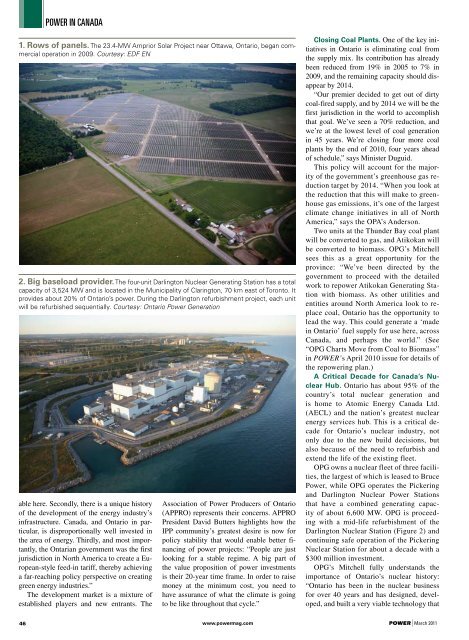Canada: A Green Energy Superpower - GBR
Canada: A Green Energy Superpower - GBR
Canada: A Green Energy Superpower - GBR
You also want an ePaper? Increase the reach of your titles
YUMPU automatically turns print PDFs into web optimized ePapers that Google loves.
power in canada<br />
1. Rows of panels. The 23.4-MW Arnprior Solar Project near Ottawa, Ontario, began commercial<br />
operation in 2009. Courtesy: EDF EN<br />
2. Big baseload provider. The four-unit Darlington Nuclear Generating Station has a total<br />
capacity of 3,524 MW and is located in the Municipality of Clarington, 70 km east of Toronto. It<br />
provides about 20% of Ontario’s power. During the Darlington refurbishment project, each unit<br />
will be refurbished sequentially. Courtesy: Ontario Power Generation<br />
able here. Secondly, there is a unique history<br />
of the development of the energy industry’s<br />
infrastructure. <strong>Canada</strong>, and Ontario in particular,<br />
is disproportionally well invested in<br />
the area of energy. Thirdly, and most importantly,<br />
the Ontarian government was the first<br />
jurisdiction in North America to create a European-style<br />
feed-in tariff, thereby achieving<br />
a far-reaching policy perspective on creating<br />
green energy industries.”<br />
The development market is a mixture of<br />
established players and new entrants. The<br />
Association of Power Producers of Ontario<br />
(APPRO) represents their concerns. APPRO<br />
President David Butters highlights how the<br />
IPP community’s greatest desire is now for<br />
policy stability that would enable better financing<br />
of power projects: “People are just<br />
looking for a stable regime. A big part of<br />
the value proposition of power investments<br />
is their 20-year time frame. In order to raise<br />
money at the minimum cost, you need to<br />
have assurance of what the climate is going<br />
to be like throughout that cycle.”<br />
Closing Coal Plants. One of the key initiatives<br />
in Ontario is eliminating coal from<br />
the supply mix. Its contribution has already<br />
been reduced from 19% in 2005 to 7% in<br />
2009, and the remaining capacity should disappear<br />
by 2014.<br />
“Our premier decided to get out of dirty<br />
coal-fired supply, and by 2014 we will be the<br />
first jurisdiction in the world to accomplish<br />
that goal. We’ve seen a 70% reduction, and<br />
we’re at the lowest level of coal generation<br />
in 45 years. We’re closing four more coal<br />
plants by the end of 2010, four years ahead<br />
of schedule,” says Minister Duguid.<br />
This policy will account for the majority<br />
of the government’s greenhouse gas reduction<br />
target by 2014. “When you look at<br />
the reduction that this will make to greenhouse<br />
gas emissions, it’s one of the largest<br />
climate change initiatives in all of North<br />
America,” says the OPA’s Anderson.<br />
Two units at the Thunder Bay coal plant<br />
will be converted to gas, and Atikokan will<br />
be converted to biomass. OPG’s Mitchell<br />
sees this as a great opportunity for the<br />
province: “We’ve been directed by the<br />
government to proceed with the detailed<br />
work to repower Atikokan Generating Station<br />
with biomass. As other utilities and<br />
entities around North America look to replace<br />
coal, Ontario has the opportunity to<br />
lead the way. This could generate a ‘made<br />
in Ontario’ fuel supply for use here, across<br />
<strong>Canada</strong>, and perhaps the world.” (See<br />
“OPG Charts Move from Coal to Biomass”<br />
in POWER’s April 2010 issue for details of<br />
the repowering plan.)<br />
A Critical Decade for <strong>Canada</strong>’s Nuclear<br />
Hub. Ontario has about 95% of the<br />
country’s total nuclear generation and<br />
is home to Atomic <strong>Energy</strong> <strong>Canada</strong> Ltd.<br />
(AECL) and the nation’s greatest nuclear<br />
energy services hub. This is a critical decade<br />
for Ontario’s nuclear industry, not<br />
only due to the new build decisions, but<br />
also because of the need to refurbish and<br />
extend the life of the existing fleet.<br />
OPG owns a nuclear fleet of three facilities,<br />
the largest of which is leased to Bruce<br />
Power, while OPG operates the Pickering<br />
and Darlington Nuclear Power Stations<br />
that have a combined generating capacity<br />
of about 6,600 MW. OPG is proceeding<br />
with a mid-life refurbishment of the<br />
Darlington Nuclear Station (Figure 2) and<br />
continuing safe operation of the Pickering<br />
Nuclear Station for about a decade with a<br />
$300 million investment.<br />
OPG’s Mitchell fully understands the<br />
importance of Ontario’s nuclear history:<br />
“Ontario has been in the nuclear business<br />
for over 40 years and has designed, developed,<br />
and built a very viable technology that<br />
46<br />
www.powermag.com POWER | March 2011

















